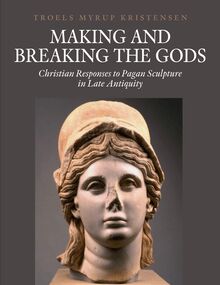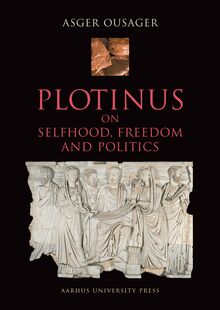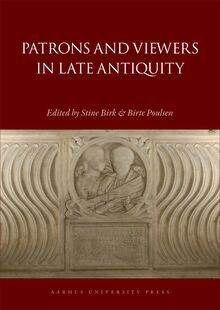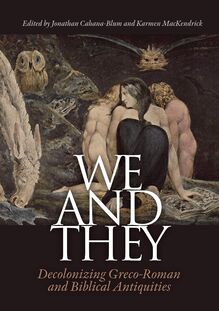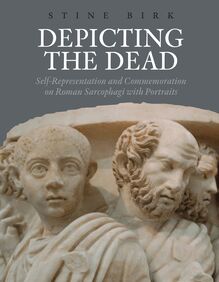Depicting the Dead , livre ebook
335
pages
English
Ebooks
2013
Obtenez un accès à la bibliothèque pour le consulter en ligne En savoir plus
Découvre YouScribe en t'inscrivant gratuitement
Découvre YouScribe en t'inscrivant gratuitement
335
pages
English
Ebooks
2013
Obtenez un accès à la bibliothèque pour le consulter en ligne En savoir plus
Publié par
Date de parution
04 février 2013
Nombre de lectures
1
EAN13
9788771244168
Langue
English
Poids de l'ouvrage
39 Mo
Publié par
Date de parution
04 février 2013
Nombre de lectures
1
EAN13
9788771244168
Langue
English
Poids de l'ouvrage
39 Mo
·
stine birk Depicting the Dea D
a arhus s tu D ies in Me D iterranean a ntiquity V olu M e X i
ISBN978-87-7124-018-4 s tine b irk
9 788771240184
Depicting
the DeaD
Self-Representation and Commemoration
on Roman Sarcophagi with Portraits
in second- to fourth-century r ome, sarcophagi were a popular burial
form, and men, women, and children from different strata of society
were laid to rest in marble coffins with lavish relief-decoration. the
visual language of these sarcophagi used mythological narratives,
learned scenes, and playful cupids to construct particular memories
of both families and individuals. standardised sarcophagi could be
individualised through the application of a portrait of the deceased
person to one of the depicted figures. the present book explores
how to read r oman sarcophagi, starting from those adorned with
portraits and placing them within a social context. it investigates
gender values and childhood as reflected in the visual language of
sarcophagus reliefs and shows how standardised iconography could
be used to construct personal and social memory.
a arhus u ni V ersity p ress a
DepictingTheDead_overtræk.indd 1 15/01/13 12.07
In memoriam
Lissi AstrupDepicting the DeadAarhus Studies in
Mediterranean Antiquity
(ASMA)
XI
ASMA is a series which is published approximately once a year by the research
programme Classical Antiquity at Aarhus University, Denmark.
Te programme includes researchers from various disciplines studying
GraecoRoman Antiquity, such as Classical Archaeology, Classical Philology, Ancient
History, the Study of Religion, and Teology.
Te objective of the series is to advance the interdisciplinary study of Antiquity
by publishing articles, e.g., conference papers, or independent monographs,
which among other things refect the current activities of the programme.Depicting the Dead
Self-Representation and Commemoration
on Roman Sarcophagi with Portraits
Stine Birk
Aarhus University Press | Depicting the Dead
© Aarhus University Press and the author, 2013
Cover by Jørgen Sparre
Illustration: Rome, Museo Nazionale Romano, Palazzo Massimo, inv. 126372 (cat. 645)
Typeset with Adobe Garamond by Narayana Press
Ebook production: Narayana Press
ISBN 978 87 7124 416 8
ISSN 1399 2686
Aarhus University Press
Langelandsgade 177
DK-8200 Aarhus N
www.unipress.dk
International distributors:
Gazelle Book Services Ltd.
White Cross Mills
Hightown, Lancaster, LA1 4XS
United Kingdom
www.gazellebookservices.co.uk
ISD
70 Enterprise Drive, Suite 2
Bristol, CT 06010
USA
www.isdistribution.com
Published with the financial support of
Aarhus University Research Foundation
Elisabeth Munksgaard FondenCONTENTS
7 Acknowledgements
9 INTRODUCTION
Negotiating Identity on Sarcophagi
21 CHAPTER 1
Images for Contemplation
59 CHAPTER 2
Exempla Virtutis: Portraits and Self-Representation on Sarcophagi
115 CHAPTER 3
Visualising Gender
157 CHAPTER 4
Filiae Innocentissimae, Filio Dulcissimo: Commemorating Children
181 Retrospect
185 Bibliography
197 APPENDIX A
Sarcophagi Commemorating Women, Men, Children, and Couples
199 APPENDIX B
Sarcophagi with Blank Portraits
200 APPENDIX C
Learned Figures with Portraits on Sarcophagi
203 CATALOGUE
How to Use the Catalogue
Non-Narrative Scenes with Learned Figuresative Scenes with Figures without Scrolls or Musical Instruments
Clipeus Busts of a Couple
Hunters and Virtus
Reclining Figures
Figures Riding in a Carriage
Mythological Figures
Children’s Life Course
Commanders (battle)
Profession (?)
Rituals (dextrarum iunctio, sacrifice, and prayer)
Addenda
325 Index
| Contents 5CONTENTS INDEX
Acknowledgements
Te present monograph is the outcome of years of fas - for reading both early and later versions of the text,
cination with sarcophagus reliefs. In 2009 I defended Hanne Sigismund Nielsen for discussions of the role
my PhD on third-century Roman sarcophagi at Aarhus of women and for assistance with the inscriptions, and
University, supervised by Dr. Björn Christian Ewald and Lea Stirling, who during her time as a visiting professor
Professor Emeritus Niels Hannestad, and this mono- at Aarhus University was a gr eat inspiration.
Furthergraph refects that work in some aspects. Te ground- more, early versions of chapters were read, critiqued,
work for the catalogue had at that time been completed, and signifcantly improved by my colleague at Aarhus
but it has been revised and substantially expanded in University Birte Poulsen. A special thank you to my
the present version. Te entire corpus of sarcophagi friend and colleague Lone Iversen for help with the
with portrait fgures has been included here, including catalogue and for locating around the world sarcophagi
those from the second and fourth centuries as well as previously unknown to me.
the third. In writing this book a greater focus was put As for the committee of my PhD, I am greatly in -
on the portrait fgure and issues of the commemoration debted to Michael Koortbojian and Janet Huskinson,
and representation of individuals. First and foremost, not least for pointing out both the weaknesses and the
I am grateful to the Carlsberg Foundation for fund - positive aspects of my study and for fruitful discussion
ing my postdoctoral work. It is their fnancial support at the defence. Tey encouraged me to continue work
that has allowed this study to come to completion. I on the material. Special thanks go to Janet Huskinson,
would like to acknowledge the further fnancial support who was always ready to discuss the enigmatic world of
towards the cost of this publication that was provided sarcophagi during her visiting professorship in Aarhus.
by the Aarhus University Research Foundation and the My fnal and most heartfelt thanks are due to a
Elisabeth Munksgaard Foundation. person who has been a rock-solid support throughout
It would have been impossible to write this book the entire process: my husband Troels Myrup Kris -
without the support of colleagues, friends, and institu - tensen. He was my constant inspiration and untiring
tions. In particular, I would like to thank the Danish friend during the many troublesome phases of writing
Institute in Rome, Hoyt Fields at the Hearst Castle, this book, and he read and commented on all parts
California, Daria Lanzuelo at the German Archaelogical of the manuscript. Without him I would never have
Institute in Rome, the Staatliche Museen, Berlin, the fnished it.
Huntington Art Gallery, San Marino, and the Ny I have dedicated this book to my beloved
grandCarlsberg Glyptotek. I am grateful to Katharina Mei- mother, since a book focusing on commemoration and
necke for useful discussions and for sharing results from role models appears to me to be an appropriate
dedicaher own work on sarcophagi with me, Zahra Newby tion to the memory of a woman with admirable virtues.
for reading and commenting on the text, especially She was my own role model.
chapter 1. I am also grateful to Björn Christian Ewald
| Acknowledgements 7
This page is protected by copyright and may not be redistributedCONTENTS INDEX
INTRODUCTION
Negotiating Identity on Sarcophagi
Best of all seems the Roman custom, which publicly renders to women,
as to men, a ftting commemoration after the end of their life.
1Plutarch, On the Bravery of Women
To be remembered after death was important in memory of the person was maintained, and through
Roman society; Roman funerary arts bear witness to the memory the anima of the deceased lived on.
Passthe eforts that were made to ensure that the memory ing into oblivion was the worst possible scenario. As
2of individuals survived. According to Ulpian, monu- such, acts that erased the memory of a person were
3ments (monumenta) were erected to preserve memory. seen as a disgrace, and inscriptions warn or condemn
6In line with this tradition of using monuments to keep those who dared to desecrate or reuse a tomb.
the memory of a specifc event or person alive, funerary Sarcophagi, made for one or at most two individuals,
monuments of various kinds were erected all over the have been preserved in large numbers. Some 15,000 in
4Roman Empire. Many still stand today as expressions total survive from the Roman Imperial period, of which
of the hope for a persisting memory, particularly those it has been estimated that around 6,000 were produced
7made of durable materials, such as brick buildings in the city of Rome. Te production of sarcophagi
5or marble altars, stelae, and sarcophagi. Te Roman
view was that as long as the monument existed, the
6 See Carroll 2006, 79-83; 2011. In one instance from Rome, a
person named Gaius Annidienus Frequens tried to prevent
1 Plutarch, Moralia III, On the Bravery of Women (introduc- his tomb from being defled by passers-by ( ne quis hic urina),
tion), trans. Babbitt; Pantell 1992. CIL VI 3413. Inscriptions that aim to protect the tomb and
2 For the importance of constructing a memory, see Hope keep it within the family are frequent in the Eastern Empire,
1997; 2003; 2011. On Roman funerary culture in general, see especially on sarcophagi from Asia Minor (se
